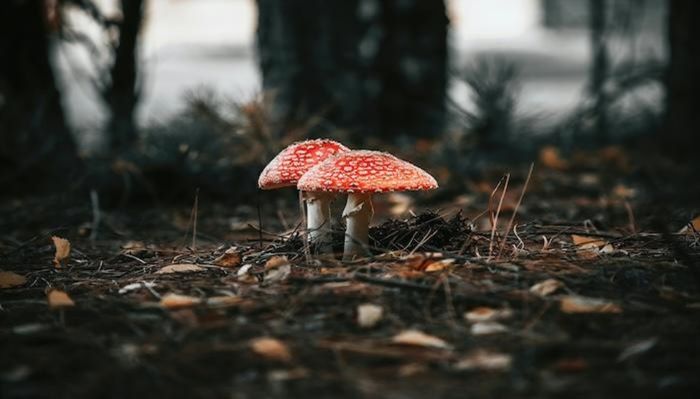Health
Amanita Mushrooms: Unveiling the Enigmatic Fungi of the Forest

In the enchanting world of mushrooms, few species are as captivating and enigmatic as Amanita. With its iconic red cap speckled with white spots, Amanita mushrooms have captured the imagination of people for centuries. But what are Amanita mushrooms, and what secrets do they hold in their mycelial realms? In this blog post, we’ll embark on a journey to demystify these intriguing fungi, exploring their characteristics, role in nature, cultural significance, and more.
The Amanita Family
Diverse and Mysterious:
Amanita is a genus of fungi that encompasses over 600 species, each with its unique features and characteristics. These mushrooms can be found in various ecosystems worldwide, from temperate forests to arctic tundras.
The Iconic Amanita Muscaria:
While Amanita encompasses a wide range of species, the most famous member is undoubtedly Amanita muscaria. This species, known for its distinctive red cap with white spots, has a long history of cultural symbolism and folklore.
Amanita in the Wild
Mycorrhizal Relationships:
Amanita mushrooms play a crucial ecological role as mycorrhizal fungi. They form symbiotic relationships with trees and plants, exchanging nutrients and minerals in a mutually beneficial partnership.
Role as Decomposers:
Some Amanita species also act as decomposers, breaking down organic matter in forest ecosystems. They help recycle nutrients, contributing to the health of the forest.
The Iconic Amanita Muscaria
Appearance:
Amanita muscaria is instantly recognizable by its vibrant red or orange cap adorned with white to cream-colored specks. The cap often resembles a fairytale toadstool.
Toxicity:
Amanita muscaria contains psychoactive compounds, including muscimol and ibotenic acid, which can induce a range of effects, including nausea, hallucinations, and delirium. It is considered toxic and potentially dangerous when ingested.
Cultural Significance
Folklore and Mythology
Amanita muscaria has been featured in the folklore and mythology of various cultures around the world. It is often associated with magic, spirituality, and mystical experiences.
Northern European Traditions: Amanita muscaria, often referred to as the fly agaric, has a rich history in Northern European folklore and mythology. In some regions, it was associated with the winter solstice and the celebration of Yule. The mushroom’s vibrant red cap and white spots made it a symbol of festive colors, and it was sometimes used as a decoration during holiday festivities.
Siberian Shamanism: Perhaps one of the most well-known cultural associations with Amanita muscaria is its role in Siberian shamanism. In Siberian indigenous cultures, the mushroom was used by shamans in their rituals. It was believed to connect the shaman with the spirit world, facilitate communication with ancestral spirits, and induce altered states of consciousness. The shaman would consume the mushroom and then guide the community through spiritual experiences.
Santa Claus Connection: Amanita muscaria’s appearance, with its red and white colors, has led to speculation about its influence on the modern Western depiction of Santa Claus. Some theories suggest that the image of Santa Claus flying on a sleigh pulled by reindeer may have been inspired by the hallucinogenic experiences associated with Amanita muscaria consumption. This connection remains a subject of fascination and debate.
Symbolism and Mysticism:
Fertility and Renewal: In some cultures, Amanita muscaria was linked to themes of fertility and renewal, possibly due to its appearance during certain seasons. Its growth in coniferous forests, often near evergreen trees, contributed to its association with life and vitality.
Mystical Experiences: The psychoactive effects of Amanita muscaria were seen as a gateway to mystical experiences and spiritual revelations. It was believed that the mushroom could provide insights, visions, and a deeper understanding of the universe.
The Amanita in Art: The striking appearance of Amanita muscaria has inspired artists and storytellers throughout history. It has been featured in various forms of art, literature, and fairy tales, adding to its cultural significance and enduring allure.
Modern Interpretations.
Contemporary Uses:
While Amanita muscaria has a rich history in traditional practices, its contemporary use is a subject of debate and caution. Some individuals experiment with it for its psychoactive effects, but its safety and legality remain concerns.
Scientific Interest:
Amanita mushrooms have piqued the interest of researchers studying mycology and mycorrhizal relationships. They continue to unlock the mysteries of these fungi’s ecological importance and potential medicinal properties.
The Mysteries of Amanita
Amanita mushrooms, with their striking appearance and rich cultural history, continue to intrigue and inspire. Whether you encounter them in the depths of a forest, depicted in folklore, or in contemporary discussions, Amanita mushrooms remind us of the fascinating world of fungi. While they hold a special place in human culture and nature’s ecosystems, it’s essential to approach them with respect, caution, and a deep appreciation for the mysteries they embody. As we explore the world of Amanita mushrooms, we find ourselves drawn into the wondrous tapestry of the natural world, where every fungi’s tale is a story waiting to be told.


















































